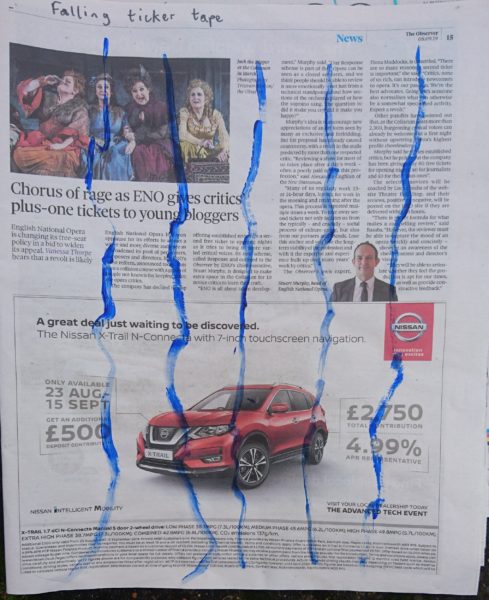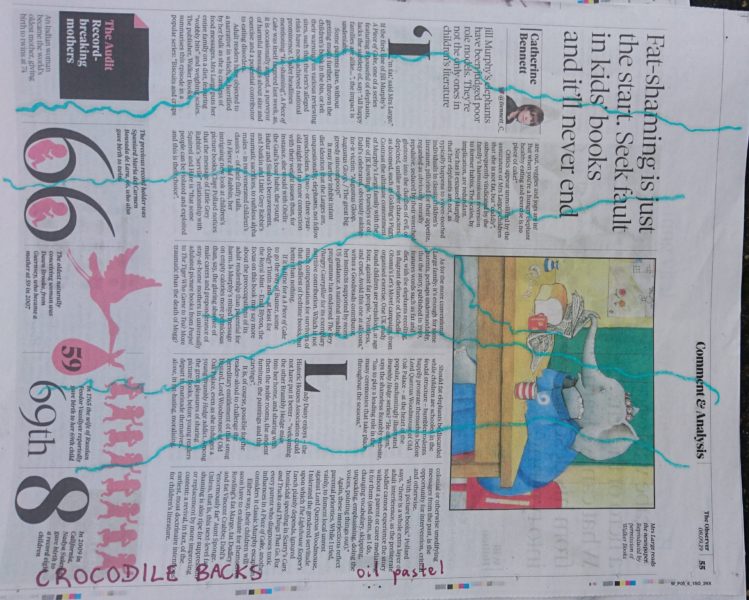Line and emotion: a warm-up exercise
September 29, 2019

Introduction
Why warm up?
Creating visual art can be a wonderfully free and intuitive process. But, for a bit of “fine tuning”, it’s worth starting off your day in the studio with a warm up exercise or two.
A quick physical warm up is as useful for the artist as it is for the dancer or runner. It frees up the drawing hand and arm in preparation for making sweeping brush strokes, charcoal marks or whatever else is required.

The best warm ups also improve the link between the artist’s mind and her drawing hand. The exercise outlined below not only improves physical brush strokes, but also focuses on the connection between emotional thought and what is put onto paper.
Words, meaning and brush strokes
The quality of brush strokes can infuse an artist’s work with added meaning. This is one way in which the best drawings or paintings go beyond a photographic representation. I’ve mentioned brush strokes, but am referring here to any linear artists’ marks: pen lines, dripped paint, lines of pastel, charcoal, pencil, etc.
Lines drawn with a broad sweep can suggest movement within a picture; halting, jagged ones may hint at fear or tension; smoothly curved sinuous lines can give a sensuous feel to an image. Take a look at Old Master drawings to see how the types of line that they have chosen to use affect the emotional punch of their pictures.
The exercise that follows links words with mark-making. Each artist’s response to this will be different and there is no right or wrong outcome. The idea sprang from an article that I came across in the latest edition of Broadleaf. It’s a beautiful piece of writing by Robert Macfarlane in which he describes his favourite tree, a huge plane under the branches of which he spends time thinking, writing and teaching. “When you step inside, light moves differently – and in my experience, so does the mind…” Below is a paragraph from Macfarlane’s article:
“Like its possible pasts, the plane divides with intense energy. It is vast – about 75ft tall – and from its 20ft-wide trunk extend 15 or so radial branches, and off those come hundreds of secondaries, off which come thousands of tertiaries, and so on. Each has made a distinctive route through the air. The forms of some remind me of lightning bolts, or falling ticker tape, or crocodile backs, of noodley wibbles, of lines of bird flight and hippodrome curves. Paul Klee would have approved of this tree: it takes lines for walks with ceaseless invention.” Robert Macfarlane

The exercise
Materials required
Use any medium in which you’re happy to make linear marks. Brush and ink is perfect. Paint is also a good choice, diluted if needed to a fluid consistency.
Feel free to use your choice of dry medium instead. Charcoal or graphite sticks, soft or hard pastels, pens of any type or oil pastels are great. If working big, consider using very chunky sticks of charcoal, oil sticks or a large brush loaded with paint.
Any support of you choice is fine. I use sheets of old newspaper for this exercise. The fact that they’re destined for the recycling box gives me an extra sense of freedom.
The exercise: Start with words
Choose some words, then simply make some marks in your chosen medium based on those words. Let’s start with Robert Macfarlane’s list of descriptive terms for his tree. These are all perfect for this purpose. Pick just one idea at a time from the following:
- lightning bolts
- falling ticker tape
- crocodile backs
- noodley wibbles
- lines of bird flight
- hippodrome curves

In my example above, I’ve used a brush dipped in paint to make linear marks suggesting “falling ticker tape”. I aimed to have the paint suggest a paper ribbon falling with a few unexpected twists and turns from the top to the bottom of the page, marking time as it falls. Of course, “falling ticker tape” will mean different things to different people. While I understood it as time-marking tape from the physics lab, it could to another artist suggest paper strips thrown in celebration from an open window, and to someone else it may mean strips containing stock market information. The point of the exercise is to have a word-related idea in your mind, and to draw or paint single-line marks to convey this idea.
“draw or paint single-line marks to convey your word-related idea.”

In the next example, I used oil pastel to make lines suggesting bumpy and somewhat arched “crocodile backs” (above).
Adding in new words
The best words to use for this exercise are those that mean something to you, the artist.
Good starting points are words or phrases suggesting something in the real world that is linear. The best examples also suggest movement, the potential for movement, and/or have a strong emotional link. Paul Klee talked about taking lines for a walk. Your lines can also swoop, fall, glide and race.
Here are a few suggestions:
- Slug trails
- Puppys’ tails
- Aeroplane trails
- Wagon tracks
- Horses’ backs

Here are more suggestions:
- Tumbling ribbons
- Vine’s tendrils
- Swans’ necks
- Drizzled honey
- Tops of babies’ heads
And a few more:
- A tear rolling down a cheek
- Trailing blood
- Life-saving rope
- Prison bars

Use your marks to convey your emotional response to the chosen word or phrase. For the “prison bars” exercise above, I wanted the pastel marks to look strong and unbreakable, but also to suggest a sense of frustration and perhaps of violence and oppression. I was not aiming to draw realistic sets of prison bars.
“Use your marks to convey your emotional response to the word or phrase.”
Several lines on a page
Make several marks per page, all based on the same word or phrase. Repetition will allow you to improve as you go along. Adjust as needed the amount of paint on your brush, the speed of movement of your drawing arm, the pressure of your line, the width of your line and so on.
Without spending much time on this, space the marks across the page in a way that both pleases you and feels appropriate. There is no right or wrong way to do this, but consider the shapes of the gaps between the lines as well as the lines themselves. You might decide to space the lines at regular intervals across the page, or perhaps instead prefer to bunch them up together.

If making marks on newspaper, then you may also choose to have your marks interact with the placement of and meaning of the underlying print (as in the prison bars example, above).
Learning from the exercise
Set about this exercise in a playful way and see what happens. Did your marks come out as intended? If not, then feel free to have another go, this time with a different amount of paint on your brush, or with a faster or slower movement of your drawing arm, or applying less or more pressure as you create the mark.
This exercise can also be useful in showing up how we might improve the link between our own mind and mark-making skill. For example, in the crocodile back exercise (above), I’d hoped to use my pastel marks to suggest the incredible stillness of these creature’s backs. This hadn’t worked as intended: instead, my lines appear to be tumbling along. A weightier, more regular line applied more slowly might give a more convincing effect of stillness.
For ideas on how lines can suggest movement and emotion, keep your eye out for marks found within great drawings and paintings.


oil paint on canvas, 143.2 x 133cm. Look at the angular, thrusting quality of the black and red-brown marks within the gates and main building. These brush strokes suggest strength but also, perhaps, some kind of impenetrability or oppression. It is a powerful image with great emotional tension.
